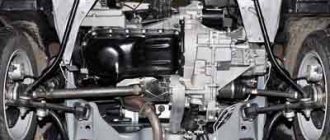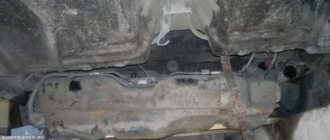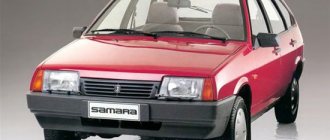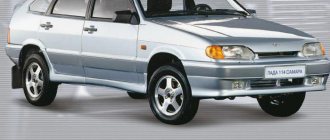Dimensions Lada Vesta
Trunk Lada Vesta
The new model of the domestic automobile industry quickly gained popularity due to its modern appearance and respectable size. The dimensions of the Lada Vesta correspond to cars in the intermediate B+ segment, noticeably exceeding the body dimensions of other AvtoVAZ models. Due to the increase in external parameters, the internal dimensions of the machine have changed in a positive direction.
Engine
- 21129
- 21179
Engine 21129 1.6 106 hp
The first engine that appeared on Vesta with the index 21129 with a volume of 1.6 liters.
Power type - injector
Volume - 1.6 l
Cylinders/valves - 4/16
Power/torque – 106 hp/148 Nm
Fuel - gasoline with an octane number of 92/95* (maximum engine power indicators were measured and are available on 95-octane gasoline. Outside measurements showed that engine power on 92-octane gasoline is 102 hp)
Until recently, only the 21129 engine was installed on Vesta. But at the end of 2016, the first Vestas appeared with a 21179 1.8 liter engine paired with a domestic robot. As for the power unit from foreign friends of the Renault-Nissan alliance, the Nissan engine produces 110 hp. and a volume of 1.6 liters is not yet installed on Vesta.
Engine 21179 1.8l 122hp
Installed on Vesta since the end of 2016. Number of cylinders -4
Power - 122 hp.
Volume - 1.8 l
New motor, with new blocks and attachments. More details in the article: 21179
Environmental standards Euro-5 (the entire range of engines complies)
Vesta interior dimensions
External parameters also determine the internal volume of the car - the size of the Lada Vesta's interior. The long, roomy body allows you to transport 5 people of average build.
Trunk of Lada Vesta. Photo source: https://autospot.ru/brands/lada/vesta_sw/wagon/
Main parameters of the salon:
- height from the front (front) seat cushion to the ceiling – from 939 to 990 mm, cushion length – 450 mm;
- height from the rear passenger seat cushion to the ceiling – 896 mm, cushion length – 480 mm;
- the distance from the backs of the front seats to the feet of the rear passengers is 226 mm.
The interior decoration is attractive and ergonomic. The upholstery uses fabric, leatherette (in “Classic” and “Comfort” versions), leather (“Lux”).
Safety
Seat belts with squib.
Driver airbag + passenger airbag with deactivation function (depending on equipment).
Body rigidity - 18500N.m/degree. It is worth noting that this is a very decent indicator; the car has the right to be called safe!, as recent crash tests have shown.
Emergency warning system ERA-GLONASS (on all trim levels)
Dimensions of Lada Vesta
There are 6 modifications in the model range. Traditional domestic bodies (sedan, hatchback, station wagon) and creative foreign ones (cross, sport) are presented. In the future - a coupe.
Dimensions of Lada Vesta SV Cross and X-Ray. Photo source: https://www.drive2.ru/l/538198298486376010/
Versions of Lada Vesta:
- Classic. The car is equipped with a driver's seat airbag and an on-board computer. There is also ESC stabilizer, electric power steering, and electric windows in the front doors.
- Comfort. In addition to standard equipment, “Comfort” has heated front seats, climate control, and rear parking sensors.
- Luxe. The model, whose price exceeds the “Classic” version by almost 200 thousand rubles, is distinguished by a rich “stuffing”: electric windows of the rear doors, PTF (fog lights), heated windshield, navigator, DD (rain sensor), alloy wheels, clutch actuator ( for robotic automatic transmissions). A touchscreen multimedia system is available at an additional cost.
- Exclusive. The developers continued to take care of safety: side airbags, Era-Glonass system, immobilizer, daytime running lights. During emergency braking, the hazard warning lights automatically turn on.
Passenger cars are divided into categories. There is no universal classification in the world; the Russian auto industry gravitates towards the European division of cars according to external parameters. The dimensions of the Vesta sedan place it in the middle class D.
Length of Lada Vesta
This parameter is important to know in order to calculate the size of the garage and entrance gate.
The size is determined with a tape measure. Length is the distance from the most protruding point of the car's front bumper to the farthest part of the rear. The length of the Vesta sedan (L) is indicated in the operating instructions - a record 4410 mm. To check for skeptics: the car is placed on a level surface, plumb lines are attached to the protruding parts of the bumpers or a building level is applied, points are marked on the ground, and the distance between them is measured with a folding meter.
Reviews and comparisons of the lengths of the station wagon and cross body showed the identity of the standard sedan modification. The hatchback is shorter: 4250 mm.
Width of Vesta with and without mirrors
Russian GOST 22748-77 defines the width (W) of a car as “... the distance between two planes of the vehicle, parallel to the longitudinal median and tangent to the vehicle on each side.” That is, all protruding parts of the car (wheel hubs, sills, door handles) are located between these parallel planes. But this does not include rear-view mirrors, side marker lights, flexible mud flaps, or swollen tires.
Dimensions Vesta SW. Photo source: https://dricar.ru/topic2994.html
Width of Lada Vesta:
- with mirrors – 2039 mm;
- without them - 1764 mm.
The distance between the right and left wheel arches, which many drivers consider to be wide, in hatchbacks, sedans and station wagons is 1680 mm.
Other standard modification parameters:
- ground clearance - 178 mm (under the engine crankcase);
- wheelbase – 2635 mm;
- front track – 1500 mm, rear – 1510 mm.
Ground clearance in Lada Vesta SW is 203 mm. Overall dimensions allow Vesta to compete with higher class cars.
Height of Vesta
This size is determined from the ground level to the upper plane of the roof, excluding the antenna and roof rails. According to AvtoVAZ, the height of the Vesta sedan is 1512 mm. According to the measurements of Autoreview journalists - 1497 mm. The difference can be explained by overinflated tires or vehicle equipment.
In all modifications of Vesta, the height meets the requirements of a family car. The cross version received the highest height in the line – 1532 mm.
Suspension
The chassis of the Lada Vesta is an advantage of this car.
The rear is completely taken from the Renault Megane, but the engineers did a very good job with the front, creating it from scratch using L-shaped arms, mounting on a subframe and MacPherson struts. Some components, of course, were taken from Alliance cars, but in general it was the front suspension that turned out to be a unique and successful development by our engineers. Precise tuning and successful suspension design made Vesta a comfortable and obedient car. Even in the very first tests, experts noted the car’s obedience, its directional stability in corners and other advantages.
Content:
However, buyers of cars of this class pay attention not only to visual appeal, but also to practicality and functionality, which are largely determined by the dimensions of the vehicle. In this regard, Vesta is also at its best, since it surpasses in basic parameters not only domestic models, but also most competitors in its class.
Comparison with competitors
The Lada Vesta, which took first place in sales in 2022, has many rivals. Domestic cars are compared with a number of foreign brands.
Hyundai Solaris
The Korean-designed sedan is assembled on assembly lines in St. Petersburg. Gasoline engine, two types of transmission and ground clearance lower than that of the Lada Vesta - 16 cm.
External dimensions: LxWxH (in mm) – 4405×1729×1470. Trunk volume - 370-480 l - depends on the configuration.
For comparison: the dimensions of the 2022 Lada Vesta station wagon are 4410x1764x1512 mm.
Hyundai Solaris lags behind the sales leader by almost 40 thousand cars per year.
Volkswagen Polo
The Kaluga front-wheel drive competitor is inferior in sales and size to the Lada Vesta sedan. The configurations of the cars are approximately the same.
Polo dimensions:
- D – 4390 mm;
- W – 1699 mm;
- B – 1465 mm.
Trunk volume - 460 l.
Kia Rio
The five-seater family "Korean" - the main rival of the Lada Vesta - is produced in St. Petersburg in sedan and hatchback bodies. Ground clearance in basic models is 160 mm, in the X-Line modification - 195 mm.
External dimensions: 4400x1740x1470 mm.
In terms of the number of cars sold, Kia Rio lags behind Lada Vesta by 5 thousand units.
Lada Granta
Although the cars are the same width, they are not similar in appearance when viewed from the front. "Grant" is 142 mm shorter and 3 mm taller than "Vesta". Ground clearance – 180 mm.
Body Specifications
| Engine location method | Anterior transverse |
| Wheelbase | 4 by 2 |
| Drive wheels | Front |
| Body | Sedan |
| Body length | 441.0 cm |
| Width | 176.4 cm |
| Height | 149.7 cm |
| Base | 263.5 cm |
| Front wheel track size | 151.0 cm |
| Rear wheel track | 151.0 cm |
| Ground clearance | 17.8 cm |
| Trunk volume | 480 liters |
| Vehicle weight (curb) | From 1150 to 1195 kg |
| Vehicle weight (maximum permissible) | Up to 670 kg 1 |
Transmissions
The buyer is offered two transmission options to choose from: a manual gearbox from Renault and an AMT robotic gearbox from AVTOVAZ.
The option with a “mechanics” from Renault was chosen in order to deprive the domestic car of one of the most significant shortcomings - noise in the gearbox. There was simply no time to develop and launch production of its analogue, so the choice fell on JH - this transmission has proven itself well in many cars.
Instead of a full-fledged automatic transmission, the car is equipped with a robotic transmission, which is AVTOVAZ’s own development. In fact, this is an old VAZ 2180 transmission, which was equipped with electric drives. The gearbox was created and refined together with the ZF company, and parts for it are manufactured using more precise equipment. This option has certain disadvantages: the noise in some gears has become quieter, but remains the same, the electronics do not always select gears quickly, the first gearboxes often broke and had to be replaced under warranty. The use of this option is justified from an economic point of view, since it costs noticeably less than a full-fledged automatic machine, and maintenance and repairs in the event of a breakdown will be noticeably cheaper.
What size wheels and tires
The wheel size of the Lada Vesta is also an important parameter that should be taken into account when choosing a car. This is one of the most important factors affecting the handling and maneuverability of a car, its behavior on the road - for different driving styles and different road surfaces.
Every driver knows that this indicator is changeable. That is, if you wish, you can put wheels of a different size on your car, affecting its dynamic characteristics. The vehicle manufacturer indicates in the manual the recommended parameters, compliance with which will not bring any trouble. Lada Vesta tire size installed and recommended by the manufacturer:
- sedan and station wagon – 185/65 R15, 195/55 R16;
- cross – 205/50 R17,
- sport - 205/50 R17.
The dimensions of the Lada Vesta disks in this case will be as follows:
- DIA – 60.1 mm;
- PSD – 100 mm;
- mounting holes - 4 or 5;
- rim width – 6J or 6½J (in inches);
- rim offset – 43 or 50 mm.
As for the sizes of Lada Vesta SV wheels, they are characterized by the following parameters:
- rim offset – 43 mm;
- rim width – 5½J, 6J, 6½J inches;
- bolt pattern – 4×100;
- DIA – 60.1 mm;
- tire size – 205/50 R17 or 205/50 R17.
The Lada Vesta tire size may differ from these parameters. Often the driver hopes in this way to increase the vehicle’s cross-country ability and improve its performance. However, when installing wheels at your own discretion, you should take into account that the car was tested and certified on those specified by the manufacturer. How other options will behave is unknown. It is likely that the modified car will become less stable and difficult to control. In addition, unauthorized installation of cross rims on the Lada Vesta, the size of which is not regulated, can lead to problems with the traffic police and technical inspection, and repair of the chassis under warranty will not be possible.
More about the body
The weight of the Lada Vesta, despite the increase in body dimensions, remained the same as that of the Priora.
The body itself is made of steel, without the addition of aluminum or other materials, since the manufacturer did not set a goal to reduce the weight of the car. Efforts have been made to create maximum safety for the Lada Vesta, eliminating unwanted vibrations and noise.
The body turned out to be more rigid and safer, thanks to new design technologies and the targeted use of high-strength alloys. Such innovations guarantee protection against jamming and distortion of doors and improved handling. The lighter weight was justifiably sacrificed to the multiple increase in the safety level of the Lada Vesta.











